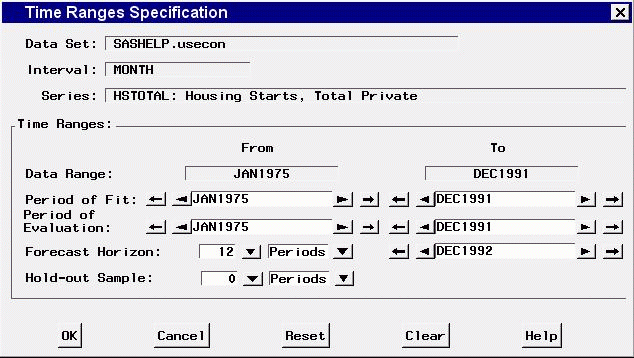Time Ranges Specification Window
Use the Time Ranges Specification window to control the period of fit
and evaluation and the forecasting horizon.
Invoke this window from the Options menu
in the Develop Models,
Manage Forecasting Project, and Model Viewer windows or the
Set Ranges button in the Develop Models window.

Controls and Fields
- Data Set
-
is the name of the current input data set.
- Interval
-
is the time interval (data frequency) for the input data set.
- Series
-
is the variable name and label of the current time series.
- Data Range
-
gives the date of the first and last nonmissing data values
available for the current series in the input data set.
- Period of Fit
-
gives the starting and ending dates of the period of fit.
This is the time range used for estimating model parameters. By default,
it is the same as the data range.
You can type dates in these fields,
or you can use the arrow buttons to the left and right of the date fields
to decrement or increment the date values shown.
Date values must be entered in a form recognized by a SAS date informat.
(Refer to SAS Language Reference for information on SAS date informats.)
The inner arrows increment by periods,
the outer arrows increment by larger amounts,
depending on the data interval.
- Period of Evaluation
-
gives the starting and ending dates of the period of evaluation.
This is the time range used for evaluating models in terms of statistics
of fit. By default, it is the same as the data range.
You can type dates in these fields,
or you can use the control arrows to the left and right of the date fields
to decrement or increment the date values shown.
Date values must be entered in a form recognized by a SAS date informat.
(Refer to SAS Language Reference for information on SAS date informats.)
The inner arrows increment by periods,
the outer arrows increment by larger amounts,
depending on the data interval.
- Forecast Horizon
-
is the forecasting horizon expressed as a number of forecast periods
or number of years (or number of weeks for daily data).
You can type a number or select one from the popup list.
The ending date for the forecast period
is automatically updated when you change
the number of forecasts periods.
- Forecast Horizon -- Units
-
indicates whether the Forecast Horizon value
represents periods or years (or weeks for daily data).
- Forecast Horizon Date Value
-
is the date of the last forecast observation.
You can type a date in this field,
or you can use the arrow buttons to the left and right of the date field
to decrement or increment the date values shown.
Date values must be entered in a form recognized by a SAS date informat.
(Refer to SAS Language Reference for information on SAS date informats.)
The Forecast Horizon is automatically updated when you change
the ending date for the forecast period.
- Hold-out Sample
-
specifies that a number of observations or years (or weeks)
of data at the end of the data range are used
for the period of evaluation with
the remainder of data used as the period of fit.
You can type a number in this field or select one from the popup list.
When the hold-out sample value is changed,
the Period of Fit and Period of Evaluation ranges are changed
to reflect the hold-out sample specification.
- Hold-out Sample -- Units
-
indicates whether the hold-out sample field
represents periods or years (or weeks for daily data).
- OK
-
closes the window and stores the specified changes.
- Cancel
-
closes the window without saving changes.
Any options you specified are lost.
- Reset
-
resets the options to their initial values upon entry to the window.
- Clear
-
resets all options to their default values.
Copyright © 1999 by SAS Institute Inc., Cary, NC, USA. All rights reserved.
